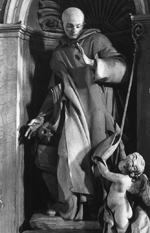St. Bruno is best known for founding the Carthusian Order, a contemplative order of hermits and nuns who maintain an extremely solitary, silent life of prayer and penitence.
The Carthusian Order, one of two orders of solitaries in the Occidental Church, has lasted more than 900 years. There are more than 300 Carthusians around the world today.
St. Bruno was not only renowned for his prodigious learning, but also for his great spirit of prayer, his severe mortification, and his devotion to the Blessed Virgin Mary.
He was born in Cologne, Germany, in about 1035, and died in Calabria, Italy, on Oct. 6, 1101.
Bruno went to a prestigious school in Rheims as a youth, known for its academic excellence. He excelled in his studies, consisting mainly of Sacred Scripture and the Church Fathers.
He returned to Cologne and was ordained a priest in 1055, but very soon after, in 1057, he was invited back to Rheims to teach.
On the retirement of the school's director, Heriman, to contemplative life, Bruno assumed the position and ran the school for 18 years, until 1075.
During that time many illustrious students emerged from under Bruno's careful intellectual formation, including Blessed Pope Urban II.
In 1075, Bruno was appointed chancellor of the Diocese of Rheims, which involved him in the daily administration of the diocese.
Bruno, however, had always been attracted to the contemplative and solitary life. In 1077, along with two companions, he made a vow to follow this lifestyle, but he was unable to fulfill his vow until 1080 due to his responsibilities as chancellor of the Rheims diocese.
After attempting different forms of solitary, or eremetical, life, Bruno founded the Carthusian order in 1084 at Chartreuse with six companions. The climate, desert, mountainous terrain and inaccessibility guaranteed strict silence, poverty and small numbers. They devoted their days to study, copying manuscripts, and prayer in their individual cells, and they would gather together only for certain prayers and celebration of the Eucharist.
However, in 1090 Pope Urban II, his friend and former student, called Bruno to the papal court in order to be his advisor, where he silently aided in all the councils of the time but remained uncomfortable away from the solitude he still desired.
On a trip to Calabria with the pope, Bruno was elected bishop of Reggio, a post he pleaded to be freed from so that he could return to monastic life. Urban II granted his wish but insisted that he remain in Italy so he could assist the pope when needed.
Bruno spent his last 10 years in the wilderness of Calabria, where he founded a hermitage with his companions and where he died in 1101. His holiness and wisdom became widely known, and his death was announced in parishes and monasteries all over Europe.
Bruno was buried in the little cemetery of the hermitage of Santa Maria, under the epitaph "Haec sunt ossa magistri Brunonis" ("These are the bones of the master Bruno"). Since the Carthusian Order maintains a strict observance of humility, St. Bruno was never formally canonized. He was not included in the Tridentine calendar, but in the year 1623 Pope Gregory XV included him in the Calendar of Saints for celebration on Oct. 6.
He is the patron saint of Calabria and of trade marks.
— Catholic News Agency
Learn more about the Carthusians
At www.diegrossestille.de/english: Watch the trailer for "Into Great Silence," the award-winning 2005 documentary about the life of Carthusian monks at the Grande Chartreuse, high in the French Alps (Chartreuse Mountains)



